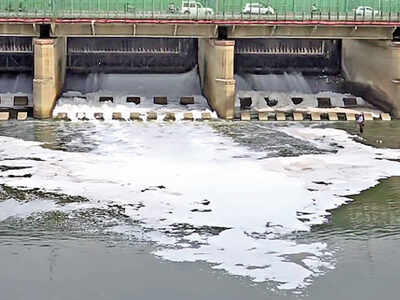
NEW DELHI: With industries resuming operations in the upstream areas of the Yamuna, the pollution level has spiked and work at three water treatment plants was hit twice on Thursday and Friday.
A senior Delhi Jal Board (DJB) official overseeing quality control said that in the past two days the ammonia level reached 3.5ppm, while the treatment plants have the capacity to treat raw river water with a maximum limit of 0.9ppm. Toxic froth was also visible at Okhla barrage, indicating that pollution in the river had again started rising.
“The ammonia level is currently around 3ppm in the raw river water. In the last three months, around 2,000-3,000 cusecs of water was being released due to which the pollution load was reduced. But now, the water being released has reduced a lot and industrial pollutants are back in Yamuna,” the official said.
Senior DJB officials said that release of industrial waste from Haryana, algae growth and low quantity of water had hit 25% of the processing capacity at Chandrawal and Wazirabad WTPs. Operations were also briefly affected at the Okhla plant.
“As the ammonia level rises, we reduce the operation of the plants in a graded manner. We dilute the raw water and keep operation at 50% to maintain the supply,” the official said.
In a statement, DJB said it was trying to rationalise supply, so water would be available at low pressure till the situation improved. “The affected areas include parts of west Delhi, north Delhi, central Delhi, south Delhi, Delhi Cantonment and New Delhi Municipal Council areas. The public is advised to make judicious use of water,” it added.
By Friday evening, the operations at Chandrawal and Wazirabad were normalised. However, due to less treatment the entire day, supply in the evening from associated underground reservoirs was affected. Officials said the problem could return in the coming days till flooding started in the Yamuna.
Industrial pollutants and spike in the ammonia level have become a recurring phenomenon with neighbouring states regularly indulging in blame game. High ammonia levels first impact Wazirabad, Chandrawal and Okhla plants, which draw water directly from the river.
A senior Delhi Jal Board (DJB) official overseeing quality control said that in the past two days the ammonia level reached 3.5ppm, while the treatment plants have the capacity to treat raw river water with a maximum limit of 0.9ppm. Toxic froth was also visible at Okhla barrage, indicating that pollution in the river had again started rising.
“The ammonia level is currently around 3ppm in the raw river water. In the last three months, around 2,000-3,000 cusecs of water was being released due to which the pollution load was reduced. But now, the water being released has reduced a lot and industrial pollutants are back in Yamuna,” the official said.
Senior DJB officials said that release of industrial waste from Haryana, algae growth and low quantity of water had hit 25% of the processing capacity at Chandrawal and Wazirabad WTPs. Operations were also briefly affected at the Okhla plant.
“As the ammonia level rises, we reduce the operation of the plants in a graded manner. We dilute the raw water and keep operation at 50% to maintain the supply,” the official said.
In a statement, DJB said it was trying to rationalise supply, so water would be available at low pressure till the situation improved. “The affected areas include parts of west Delhi, north Delhi, central Delhi, south Delhi, Delhi Cantonment and New Delhi Municipal Council areas. The public is advised to make judicious use of water,” it added.
By Friday evening, the operations at Chandrawal and Wazirabad were normalised. However, due to less treatment the entire day, supply in the evening from associated underground reservoirs was affected. Officials said the problem could return in the coming days till flooding started in the Yamuna.
Industrial pollutants and spike in the ammonia level have become a recurring phenomenon with neighbouring states regularly indulging in blame game. High ammonia levels first impact Wazirabad, Chandrawal and Okhla plants, which draw water directly from the river.

Coronavirus outbreak
Trending Topics
LATEST VIDEOS
More from TOI
Navbharat Times
Featured Today in Travel
Get the app









